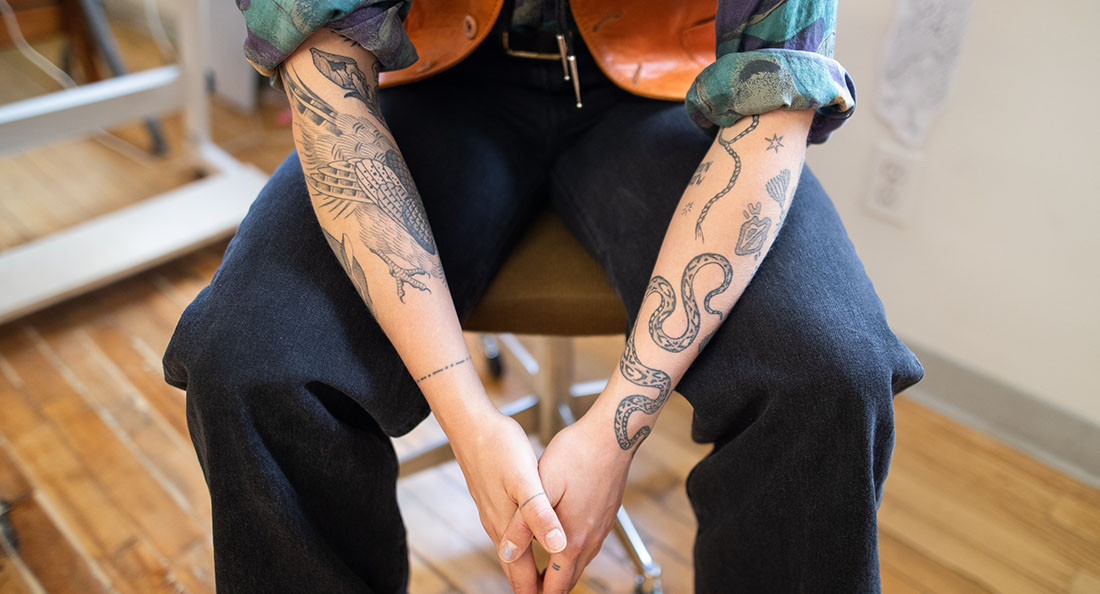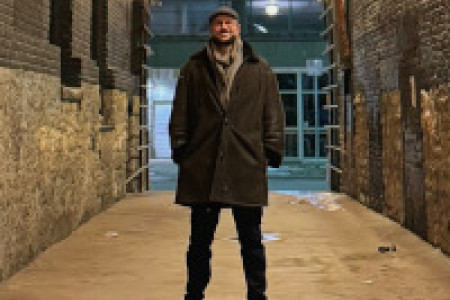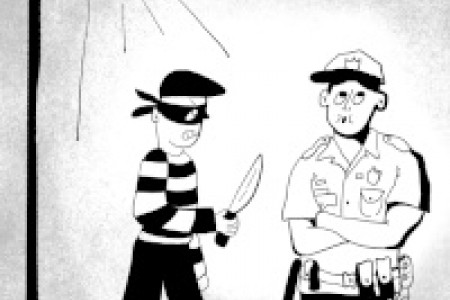Finding comfort in inked skin
Tattoos create self-expression, acceptance and conversation in queer communities
Ky Quiring sits on the cream-coloured tattoo bed in their workspace. Their cowboy boot-clad feet dangle over the edge as they point out the deer antlers hanging on the wall and the preserved duck wings in a frame.
Art from the three tattooers in the studio covers every available space on the wall, creating a mosaic of styles and colours.
Working out of Ritual Winnipeg in the Exchange District, Quiring tries to make their space a safe place for queer and transgender folks to voice their feelings and help them express themselves through tattoos.
“We’re already in a society that we’re not comfortable in, and if we can make ourselves more comfortable in our bodies, it kind of helps,” the Métis and Two-Spirit tattoo artist says. “Every tattoo that I get, at least I’m feeling more like myself in my body and I’m on the right path to that expression. We’re all the same on the inside, but we want to be different on the outside.”
Quiring’s tattoos each have special meaning, including a rabbit tattoo to mark the death of their sister’s pet rabbit and the rabbit they snared outside of the city.
Other tattoos have come to Quiring in dreams and helped them feel more in tune with their body.
“If I look in the mirror and I see a blank canvas, I actually see tattoos that are supposed to be there, or I’ll get dreams and visions of different pieces that I know are supposed to be there,” Quiring says. “It’s definitely a form of self-expression, and every time I get new tattoos, it’s like, ‘Oh my God, you were always there.’”
Since the studio opened at the beginning of October, Quiring and their coworkers Bram Adey and Holly Biberdorf have tried to create an open environment for Winnipeg’s 2SLGBTQIA+ community to get tattoos.
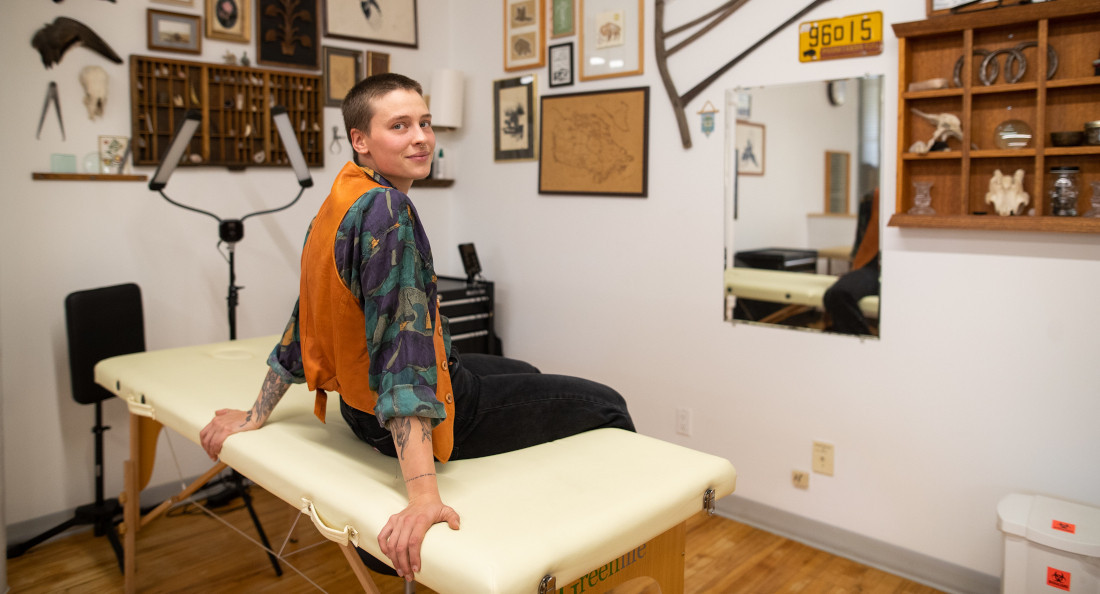
Ky Quiring sits on the cream-coloured tattoo bench in their workspace.
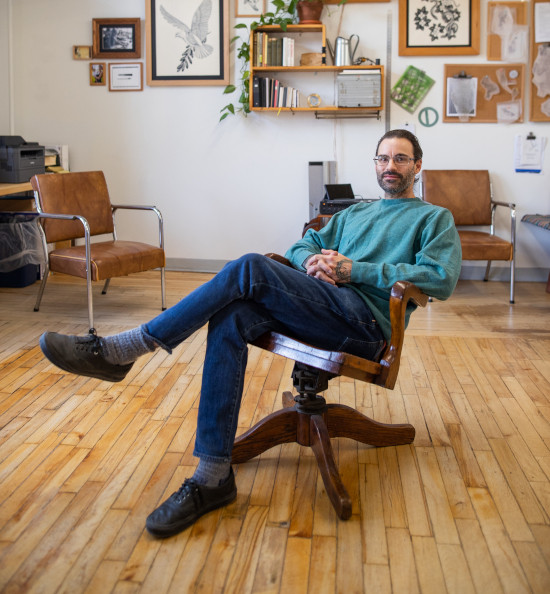
Bram Adey, owner at Ritual Winnipeg tattoo studio (70 Arthur St.)
As the shop owner, Adey wanted to make their consent forms different from other shops in the city. Most studios use these forms to verify clients’ ages and notify workers of any conditions that could complicate the tattoo process. Adey also included sections asking for consent to take photos of the finished pieces and another giving clients the right to revoke consent at any point.
“Creating the contract for staff was actually really exciting to be able to enshrine in a legal document that this is our code of conduct, this is what we expect of you,” Adey, a gender-non-conforming tattooer, says. “It’s mainly about ensuring that the people who are in positions of power in this space are very sensitive to what it means to make a safe space.”
Adey, Quiring and Biberdorf started getting tattoos as a way to feel more comfortable in their own bodies and identities as they learned more about themselves and their queerness.
Biberdorf says she started getting tattoos because she liked them but began to realize she enjoyed the connection that formed between her and the artist. She says it also helped her connect with her body and pansexual identity.
“At first it was just a way to make my body my own and a way for me to like my body more. As it progressed, I became proud of my vessel as well,” Biberdorf says. “I hope, no matter what people are struggling with on the inside, that tattooing is a way for them to just be a little more comfortable with the skin that they’re in.”
Tattooing can be an intimate process, depending on the subject or placement of the tattoo. Adey believes it’s a tattooer’s job to make their client feel safe during the vulnerable process.
They say it’s humbling to have so many queer folks come to their studio because of the environment they’ve created.
“When people come into a tattoo studio, especially the young, it’s an opportunity for them to present themselves in a new way to the world,” Adey says. “Sometimes people say things to me that maybe it’s the first time they’ve ever said to anyone or it’s the first time they’ve said it to a stranger.”
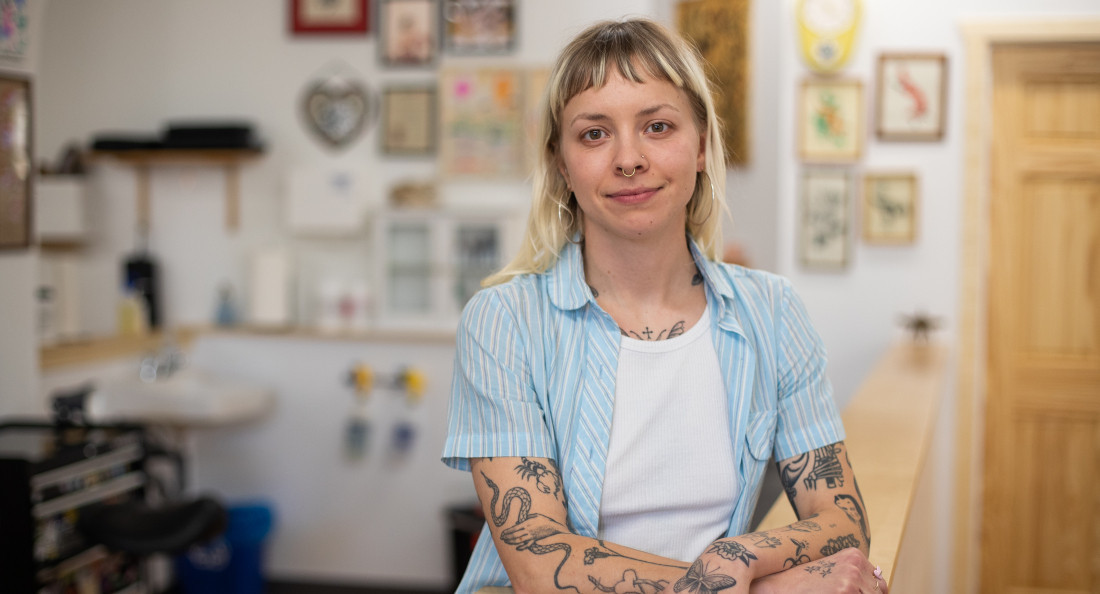
Holly Biberdorf, tattoo artist at Ritual Winnipeg
A ‘secret way to find queer people in the wild’
Kiera Garrity is 22, but she got her first tattoo while in Grade 12, around the time she started questioning her identity.
The University of Winnipeg (U of W) art-history student says her tattoos reflect who she is as a person. Her 18 tattoos include Frog and Toad riding a bicycle, a cowboy opossum, a stick-and-poke Garfield phone and a medieval knight.
The tattoos help Garrity feel more secure with who she is and connect with other queer folks in the city.
“I like that there’s this kind of secret way to find queer people in the wild. I see certain tattoos or certain styles and it’s like, okay, there is no chance in hell that you are a straight person or you’ve never questioned your gender identity,” Garrity says. “I have more things to bond with people over.”
Garrity says her experiences being tattooed by other queer people has felt less stressful then when she was tattooed by a straight artist.She says there’s less anxiety surrounding the process because she knows she will have something in common with the tattooer.
“It can already be such an intimidating environment, and I think, as a queer tattoo artist, you kind of know that. I know (there are) a lot of artists that really pride themselves in having a very comfortable studio space that doesn’t feel overly clinical or really intimidating,” Garrity says. “The comfort level is automatically so much higher.”
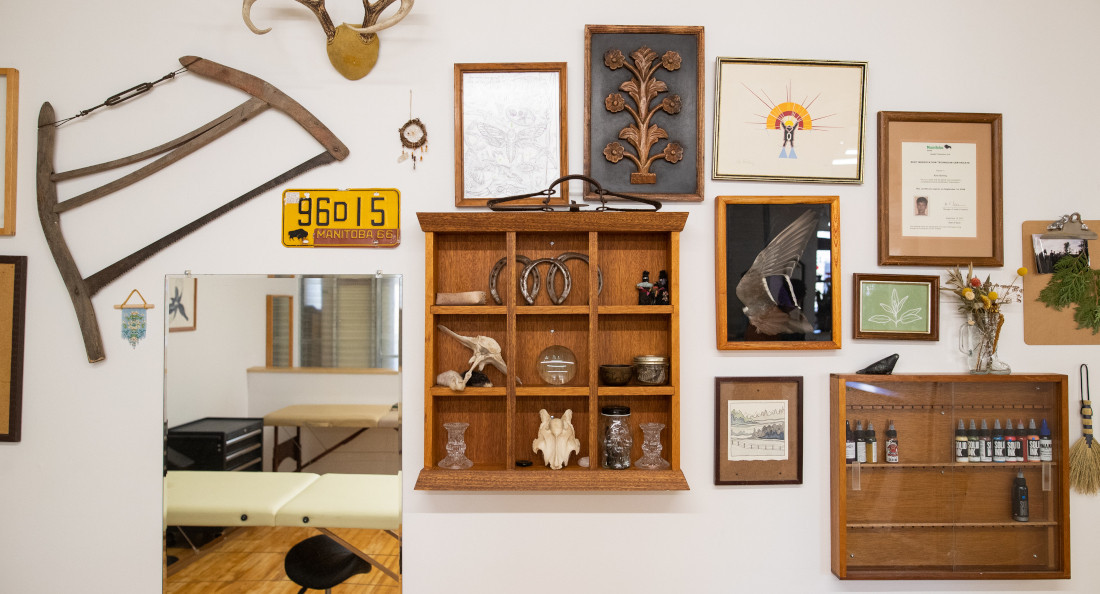
Art adorning the walls at Ritual Winnipeg
Tattoos are more than ink on skin
Anyone can use tattoos to commemorate or represent something meaningful to them, but Dr. Angela Failler believes they can be used to heal from shame or violation imposed on those in 2SLGBTQIA+ communities.
The queer U of W women’s and gender studies professor says it’s a way for people to take their bodies back while finding individuality.
“Tattoos can be both a means to carve out your individuality but also to signify your belonging to a community,” Failler says. “Individually, people also use them as a kind of embodied resistance to norms to set themselves apart from the status quo.”
She says tattoos give queer people agency over themselves.
“Skin itself is a site of communication or medium where we make meaning,” Failler says. “When people are wanting to communicate something about their own pleasure or pride or joy in the embodiment, I think tattoos become a way to do that.”
Some use tattoos to make new meaning of their bodies after surgeries or scars. Failler thinks being able to make meaning out of loss or a change in someone’s body is important and that it’s hopeful when people can signify their struggle in a meaningful way.
“Queer people have faced a lot of loss and adversity, and (they use) tattoos as commemoration, as a way of kind of incorporating memory of something or someone or some idea that has been lost in a permanent way,” Failler says. “Part of the point of tattoos is their relative permanence.”
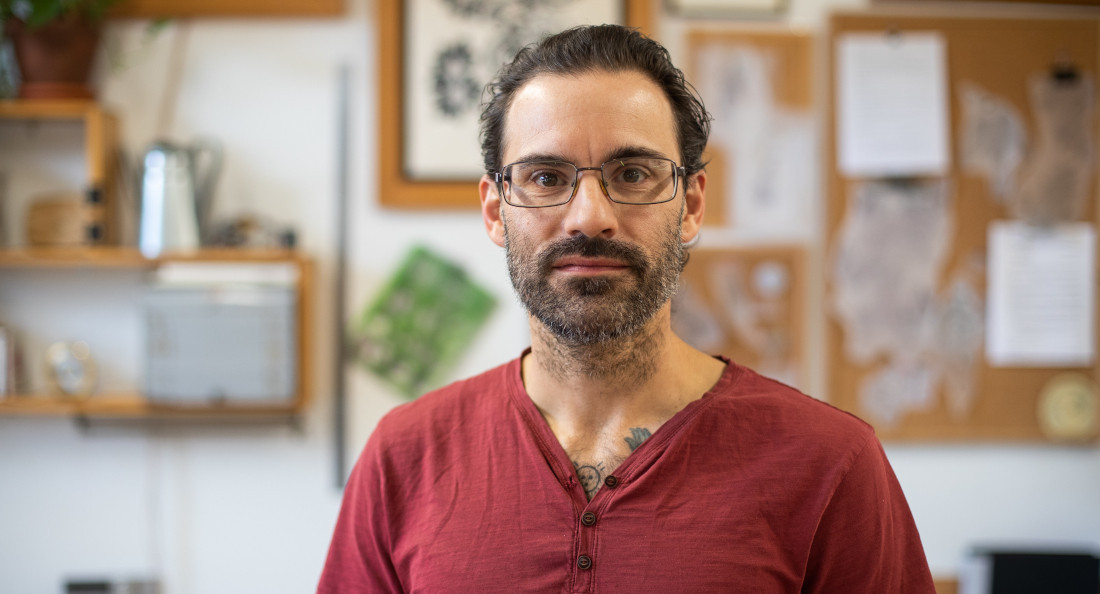
Ritual Winnipeg’s staff contracts are “mainly about ensuring that the people who are in positions of power in this space are very sensitive to what it means to make a safe space.” -Bram Adey
Inclusivity includes Indigenous communities, too
Winnipeg’s tattoo scene has historically been made up of straight white men, much like other cities across North America.
Quiring is trying to set more inclusive standards for the industry in Winnipeg. That means not only tattooing queer folks, but also helping Indigenous people reclaim tattooing as a sacred ceremony and way to connect with their cultures.
Many Indigenous cultures, like the Inuit or Māori, have facial tattoos that hold sacred or ceremonial value. These tattoos are used to tell stories, celebrate different milestones in a person’s life or offer spiritual or magical protection.
“That’s really important to me to be able to facilitate that for younger Indigenous folks who are trying to reclaim those markings even more and having someone who can do it traditionally and in a safe environment,” Quiring says.
Indigenous groups from around the world are reviving traditional facial markings and are trying to break down the lasting stigma brought by western-led colonization.
Quiring says it’s been easy having conversations about Indigenous inclusivity at Ritual Winnipeg, because the other tattooers in the studio are already so open and accepting.
“I think we’re going to be the start of the change. The older tattooers are realizing that the world is moving on,” Quiring says. “I think this is the main stepping stool for other people. Winnipeg is not a queer hub, but we’re hoping we can make it a queer hub.”
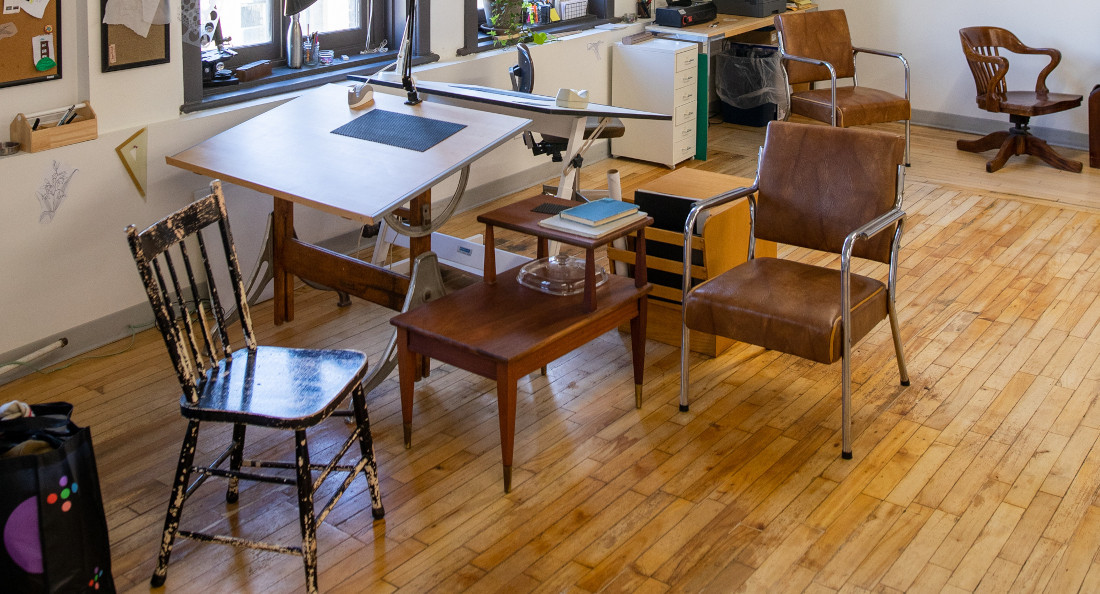
Artists’ drafting tables at Ritual Winnipeg
Published in Volume 78, Number 09 of The Uniter (November 9, 2023)

